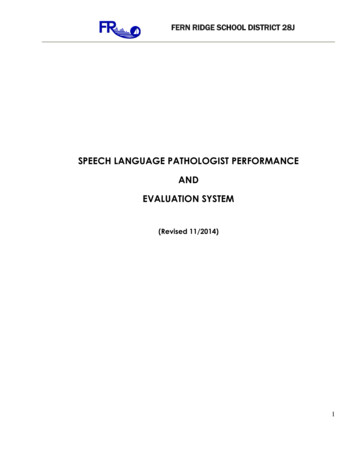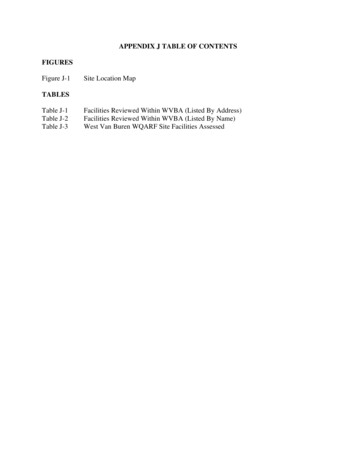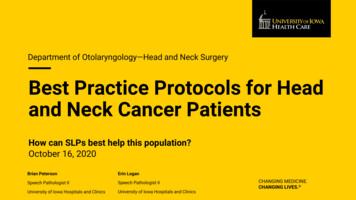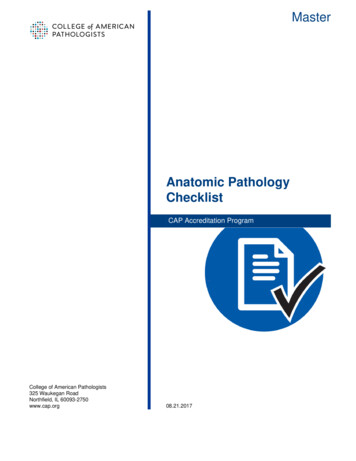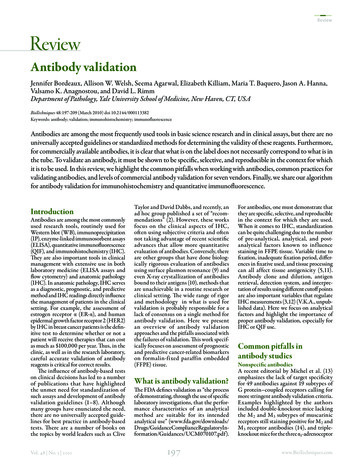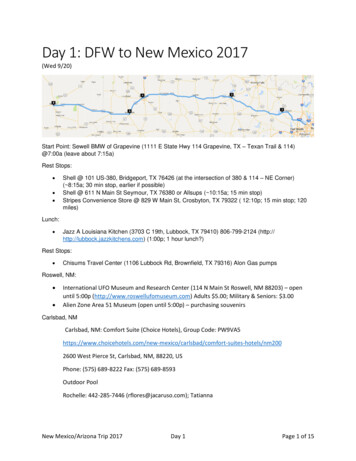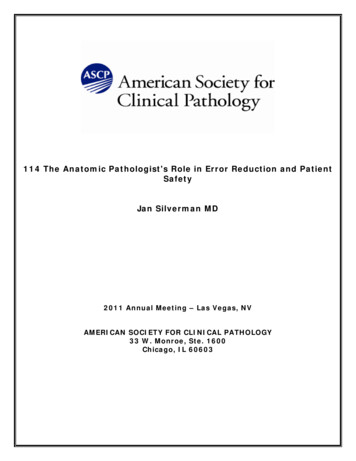
Transcription
114 The Anatomic Pathologist's Role in Error Reduction and PatientSafetyJan Silverman MD2011 Annual Meeting – Las Vegas, NVAMERICAN SOCIETY FOR CLINICAL PATHOLOGY33 W. Monroe, Ste. 1600Chicago, IL 60603
114 The Anatomic Pathologist's Role in Error Reduction and Patient SafetyThis session will increase general awareness of the pathologist's role in error reduction and the need for activeinvolvement in the error reduction process within the practice setting. Recognize which anatomic pathology cases tend to be error prone.Pathologists will recognize the value of standardization and protocols and checklists in anatomicpathology reporting.Appreciate the value of second opinion and develop processes for internal quality assurance andrecognize which types of cases would constitute critical diagnoses in anatomic pathology.FACULTY:Jan Silverman MDPracticing PathologistsPractice and Quality ManagementPractice and Quality Management2.0 CME/CMLE CreditsAccreditation Statement: The American Society for Clinical Pathology (ASCP) is accredited by theAccreditation Council for Continuing Medical Education to provide continuing medical education (CME) forphysicians. This activity has been planned and implemented in accordance with the Essential Areas and Policiesof the Accreditation Council for Continuing Medical Education (ACCME).Credit Designation: The ASCP designates this enduring material for a maximum of 2 AMA PRA Category 1Credits . Physicians should only claim credit commensurate with the extent of their participation in theactivity. ASCP continuing education activities are accepted by California, Florida, and many other states forrelicensure of clinical laboratory personnel. ASCP designates these activities for the indicated number ofContinuing Medical Laboratory Education (CMLE) credit hours. ASCP CMLE credit hours are acceptable tomeet the continuing education requirements for the ASCP Board of Registry Certification MaintenanceProgram. All ASCP CMLE programs are conducted at intermediate to advanced levels of learning. Continuingmedical education (CME) activities offered by ASCP are acceptable for the American Board of Pathology’sMaintenance of Certification Program.
Anatomic Pathologist’s Role inError Reduction and Patient SafetyJan F. Silverman,, M.D.Chair and Director of Anatomic PathologyAllegheny General HospitalProfessor, Temple University School of Medicine andDrexel University College of MedicinePittsburgh, PennsylvaniaDisclosure This presenter has no financial affiliationsto disclose.Topics Errors in Anatomic Pathology Error Reduction: Standardization,2nd Opinion, etc. Critical Values GYN and NON-GYNNON GYN CytologyRisk Management Strategies to Avoid Malpractice Summary1
Audit Methodsin Surgical Pathology Internal quality assuranceConsensus conferenceReview all path reportsSelective review Intradepartmental consultation Extradepartmental consultation Clinicopathologic conferences External quality assurance-slide circulationIOM ReportDeaths from Medical Errors Colorado & Utah studies – 44,000 deaths –NY study – 98,000 deaths 8th leading cause of death. More than MVA(44 000) B(44,000),Breastt CA (43(43,000)000) & AIDS (17(17,000)000) Total national costs – lost income, losthousehold production, disability & healthcare costs of preventable adverse events(M.E. resulting in injury) – 17 – 29 billion,(1/2 of which is health care costs)2
IOM Strategies & GoalsStrategies: Establishing a national focus to createleadership, research, tools and protocols toenhance the knowledge base about safety: Identifying and learning from errors throughmandatory reporting efforts Raising standards and expectations forimprovements in safety Creating safety systems inside health careorganizations through the implementation of safepractices at the delivery level.Goal: 50% reduction in medical errors in 5 yearsTo Err is Human, Katin, et al. National Academy Press,Washington, DC 2000Pathology & Lab Testing 70% of medical decisions that affect orchange clinical course related to labdata 60 million PAP tests/yeartests/year. 240 millionSP specimens 97% CA dx based on pathologyspecimen dx Also medical dx – GI, liver, etc.Error, IOM Definition Failure of a planned action to becompleted as intended (executionerror) Use of wrong plan to achieve an aim(planning failure)3
ErrorGeneric term to encompass allthose occasions in which aplanned sequence of mental orphysical activities fails to achieveits intended outcome.Ronald L. Sirota, MDCAP Companion Society MeetingUSCAP, March 22, 2003Error Not a reality, but a judgment- A ruling made on human performance Always assigned after outcome isknown Almost always affected by hindsightbiasRonald L. Sirota, MDCAP Companion Society MeetingUSCAP, March 22, 2003Gold Standard forCorrectness Fundamental scientific characteristic ofdisease state i.e., translocation or distinctivephenotype abn with very high dx sensitivityand specificitypy i.e.,, X:18 translocation – SS. Arbitrary Political Standards:- Most votes (normative standard)- Highest authority i.e., expert consultantFoucar et al.AJCP 82:116; S34, 20014
Interobserver VariabilityAmong Experts Rosai J – 5 pathologists evaluated 17proliferative breast lesions. No single case didall agree, and only 3 cases (18%) did 4/5 agree. Schnitt SJ, et al. – 6 pathologists reviewed 24proliferativelifi ductaldl breastblesions.l iCompleteClagreement – 58%, 5 or more in 71% and 4 ormore in 92% following use of standardizedcriteria (Page) Farmer ER, et al. – 8 experts, 37 melanocyticcases: Kappa – 50 (moderate) with 62%unanimous or 1 discordant dx; 38% had 2 ormore discordant dx.What is “ERROR” in SP Clinical significant vs. academic Error defined by prospective versusretrospective review Error defined by “expert” 2nd opinion,intradept or inter-institutional review, etc. Judicial system – error as injury resultingfrom negligence (negligence defined byexpert testimony as medical practice thatfalls below standard of care (national, notcommunity standard)Troxel, AJSP 28:1092, 2004Types of SP ErrorsBased on Audit Method Review of consecutive cases – falsenegative.g Consultation – false positive thresholderrors – spectrum of typing andgrading.Renshaw, A.AJCP 115:338, 20015
Logistics-Reporting Format Reporting surgical pathology errors – nostandardea y data suggests best methodet od iss Preliminaryto report errors/total slides reviewed NOT# of casesA. Renshaw, MDADASP San Antonio, TXFeb 2005Errors in S.P.ADASP Survey 41 questionnaires / 34 replies (academicdept.) Definitions, perceptions Measures discrepancy/errors Lack of uniformity/consistency Need for consensusKumarasen CooperADASP, San Antonio, TXFeb 2005Errors in AP 1.2% of SP reports contained significanterror (Ramsay et al 1992) 2nd pathologist review, 7/5,397 (0.1%) haderror affecting patient care (Safrin & Bark1993) and 32/2,694 (1.1%) errors in bx’s(Lind et al 1995) Major error was 1/1,000 cases (DeMay1996) AP errors (1-5%, range 0.5-43%);significant errors 0.25-8.8%, esp.neuropathology (Renshaw literaturereview AJCP 115:338, 2001)6
Dx’s Errors in APOrgan Specific Prostate (Epstein, 1996) – 2.7%CNS (Bruner, 1997) – 8.8%GYN Tumors (Selman, 1999) – 4.7%Head & Neck (Westra, 2002) – 7%Soft Tissue (Harris 1991, Folpe 2000,Arbiser et al. 2001 ) – 22-32%Soft TissueConsultative (Expert) 2nd Opinion 500 consecutive cases 266 (53.2%) accompanied by a dx- agreement – 68%- minor discrepancy – 7%- major discrepancy – 25% 65 major discrepancies- benign lesion dx as sarcoma (25%)- sarcomas dx as benign 23%)- nonmesenchymal dx as sarcoma (20%)- major grading diff (12%)Arbiser,, Folpe, WeissAJCP 116:473, 2001Problematic Soft Tissue Lesions Lipoma (6 cases) & fasciitis (5), &their variants Desmoplastic neurotropic melanoma(5) Few lesions accounted for majorportion of major discrepancies Few lesions needed IHC Needle bx’s more troublesome7
In-house Prospective Peer ReviewBefore Release of S.P. Report LIND, et al. – 32 errors (1.2% cases), 8major errors. NOVIS – 1.3/1000 0.6/1000 followingreviewi WHITEHEAD, et al. – 7.8% disagreementwith 2.2% changed dx ( 1% significant )(3,000 cases) SAFRIN & BARK – 14/5,397 (0.26% error); 7significant. 7 per case, 2,700 perdiscrepancyWhich Cases Need 2nd Opinion(Consensus Conference) Highly critical or significant casesProblem prone casesClinician flagged casesPatient flagged casesRare disordersNew procedures and specimen typesNew pathologist until competency proven and problemprone pathologist until competency issues resolvedTomaszewski J., et al.AJCP 114:329, 2000Consensus Conference onOpinion Recommendations2nd“Formal policy on application of 2ndopinionpshould be created in eachpathology department.”Tomaszewski et al.AJCP 114:329, 20008
Proposed Standards General surgicalpathology- 1% excellent- 1-2% acceptable Frozen Sections- 3%unacceptable New Pathologists- 1% keep Competency- 5%incompetent Specializationcan t sign it- 5% can’tout Second Opinion- 10%A. Renshaw, MDADASP San Antonio, TXunacceptableFeb 2005CASE 1 65 M with fever, night sweats, coughand Rt. middle lobe of lung infiltrate Under went transbronchial bx at outsidehospital, March 20079
Outside Hospital Dx Rt. Middle lobe of lung biopsy– Necrotizing granulomatous inflammationwith vasculitis– SpecialSi l stainst i forf fungusfandd AFB arenegative– D/D- Wegener’s granulomatosis, Churgstrauss syndrome, rheumatoid nodule,bronchocentric granulomatosis anddiffuse pulmonary hemorrhage.Case 1 (continued)Patient was treated with cytoxan andprednisone with no improvement. The lungcultured Nocardia. In October 2007, skinlesions developed including a chest nodulewhich was biopsied and cultured Nocardia.Patient was then treated with roceptinfollowed by bactrim with improvement. Thepatient was referred for evaluation andtreatment at AGH. Outside slides reviewed.10
11
Final Diagnosis (AGH) Organizing pneumonia withassociated BOOP like changesInterinstitutional 2nd Review 777 patients / 9.1% discordant dxChange in Rxmet – 5.8%Cytology & FNA discrepant – 21%S.P. discordant – 7.8%Abt et al.Archives Pathol Lab 119:514, 1995Mandatory Second Review 21 month period – (April 1995 – December 1996) Discordant dx – major modification in therapy orprognosis: benign vs. malignant or tumorclassification 6171 cases: 86 changed dx (1.4%) Serosal surfaces (9.5%) & GYN (5.1%)Kronz et al.Cancer 86: 2426, 1999 (Johns Hopkins Hospital)12
Incidence and Types of DiscordantDiagnosis1.4 – 5.8% - clinical impact (up to 30%, withmean 10% - clinical and non-clinical impact)Higher in certain organ system – GYN,GYN LL.N.,NG.U. (5-13%). Also PAP smears, soft tissueFNA, serosal fluids.Recent survey of 300 hospitals. ½ requiremandatory review, but ¾ of academic centersrequire it (AJSP 24:280, 2000)Mandatory Interinstitutional Pathology Consultation(IPCs) a.k.a. – Second OpinionADASP recommend adoption of IPC as “institutional policy”when patients are referred to a second institution.(AJSP 17:743, 1993)No consensus or national guidelines due to perceived cost, delayand/ord/ valuelHowever, following Institute of Medicine’s 1999 report –2ndConference – ASCP – June 2000 affirming ADASPrecommendation supporting mandatory review of extramural dx“for which major therapeutic intervention are planned based on atissue or cytologic dx” at the treating institution (AJCP 714:329,2000).13
RECOMMENDATIONS2nd opinion for:Non-emergent cases for which Rxmet donebased on outside tissue or cytology dxdx.Second opinion done at treating institution.Cases of dx discrepancy with outsideinstitution need to be resolved beforedefinitive Rxmet.Cost Benefit of SecondReview Decrease elective surgery in 11-19%casesy medical Decrease unnecessaryprocedures i.e., angiography Saved 2-4 for every 1 spent (secondreview)Kronz et alCancer 86: 2426, 1999Second Review of ProstateBiopsies 1.3% bx’s reclassified as benign prior toradical prostatectomy Atrophy & adenosis msdx. Cancelled surgery in 6/535 cases Savings 1.91 for every 1 spent on 2ndreview Cost savings – IHC, repeat bx’s, ultrasound,surgeryEpstein et al.AJSP 20:851, 199614
Pathology ErrorsWall Street Journal “Growing evidence that patients shouldalways seek a 2nd opinion on lab work whencancer is suspected or dx” Johns Hopkins (1.4%)(1 4%)Dana Farber prostate dx (10%)Northwestern (8% of breast CA)etc. on 2nd review of outside pathologyTara Parker-PopeWSJ Feb 8, 200515
Errors in Surgical Pathology Review of malpractice claims from 2 timeperiods (1995-97 & 1998 – 2003) (DoctorsCompany) 1995-97 – 218 SP claims; 1998 – 2003 – 272claimsTroxel. AJSP 28:1092, 2004SP Claims – 1995-97 54% systematic cognitive errors – 52% ofthese false neg. dx, & 33% false positive False neg. breast FNA (sampling);melanoma misdx as Spitz nevi; failure todx lymphoma in extranodal sites; frozensection misdxTroxel. AJSP 28:1092, 200416
SP Claims – 1998 - 2003 61% false neg. dx, 27% false positive Melanoma false neg.; breast bx’s,misdx ovarian tumorstumors, operationalerrors, extranodal lymphomas, F.S.Errors – Patterns & Trends Melanoma misdx increased from 11 – 16%of total claims – misdx as Spitz,unrecognized desmoplastic, etc. Breast bx, breast FNA, FS – most commoncause off pathologyth lmalpracticelti claimsl i Extranodal lymphomas Less FNA claims PAP smears decreased from 17 – 11% oftotal claims Operational errors increased from 1.8 – 8%17
Melanoma Pitfalls Doctors Company malpractice claims 19952001 – 13% involved msdx of melanoma; 2ndmost common following breast. 70% false negative. Problems – “classic” melanoma dx as nevus,nevoid melanoma, desmoplastic melanoma,dysplastic nevus, and Spitz nevus. Shave or punch biopsies.Troxel DBAJSP 27:1278, 2003Spitz Nevus Spitz nevus in adult ( 20 y.o.) send toconsultant. All Spitz nevi should be completelyexcised (in young and adult).adult)Troxel – CAPMeeting at USCAPMarch 200318
Where AP Errors OccurPre-analytic Clinician – wrong information, noinformation, wrong specimen,inadequate or wrong sampling Specimen delivery Accessioning errors Histology errorsErrors in APAnalytic Gross Room – Poor gross examination –sampling, description, measurement,margins, sectioning, wrong studies orderedor proper studies omitted Frozen Section Microscopic Diagnostic: Cognitive mistakesin msdx or omitted dx. S.P. Report: Incorrect wording, typo’s,formattingAnalytic Error AnalysisSLIP- wrong action to achieve goal- unintended automatic action- misapplying known knowledgeLAPSES- inadvertent omission of automatic action- skipping a slide- mixing up casesKnowledge gapsPoor judgment19
COGNITIVE DIAGNOSTIC ERRORS(Acad. Med. Aug 03) Anchoring: Lock-in too early/fail to adjust to laterinformationConfirmation: Look for confirming evidence to supportDx /not looking for refutationDiagnosis Momentum: One Dx label attached becomesstickier and stickierAscertainment Bias: Thinking shaped by priorexpectations/stereotypingAvailability: If things rapidly come to mind/recentexperience-more likely to occurBase rate neglect: Ignore prevalence of a diseaseCommission bias: tendency toward actionOverconfidence: Universal tendency to believe weknow more than we do COGNITIVE ERRORS (CONT’D) Premature Closure: “when the diagnosis is made,the thinking stops”Fundamental Attribution Error: comorbid medicalconditions overlookedRepresentativeness Restraint: Looking forprototypical manifestations of disease; leads tomissing atypical variantsSearch Satisfying: Call off search once something isfoundSutton’s Slip: When possibilities other than theobvious are not given sufficient considerationSunk Costs: The more you invest in a Dx, less likelyto release it, and consider alternativesVertical Line Failure: Thinking in Silo’s: inflexible:what else could it be?CASE 2SP consultation slide from outsidehospital 68 yr. old male, stomach Bx.20
21
Final DiagnosisBiopsy of stomach:- Invasive poorly differentiatedadenocarcinomaCASE 2 (continued)Patient then underwent resection ofstomach, spleen and tail of pancreasfor a 9.5 cm gastric mass22
23
S100HMB45Melan AVimentinFinal Diagnosis--Metastatic malignant melanoma, invadinginto but not through the muscularis propriaof distal stomachEightg of nine lymphy p nodes positivepformetastatic malignant melanomaCASE 3 40 yr. old female, with history of leftbreast carcinoma, status-post radiationfollowing lumpectomy, underwentmastectomy24
Fat necrosis25
Final DiagnosisLeft breast mastectomy- Rare atypical glands, consistent withresidual ductal carcinoma, high nucleargrade- Extensive fat necrosisSMMH/P63Amended DiagnosisLeft Breast, mastectomy:- Rare atypical glands, consistent withradiation effect- ExtensiveE ti fatf t necrosisi26
CASE 4 81 yr. old male with history of bladdertumor underwent bladder neck andbladder biopsiesBladder neck tissue27
Bladder tissuePreliminary DiagnosisA. Left bladder neck tumor bx.:- invasive, moderately to poorlydifferentiated urothelial (transitionalcell) carcinoma with focal glandularmetaplasiat l iB. Bladder tissue:- Adenocarcinoma- Final diagnosis pendingimmunohistochemical studies28
ImmunostainsPSAP504SPAPCK20Amended DiagnosisA. Left Bladder neck tumor, Bx.:- Moderate to poorly differentiatedadenocarcinoma consistent withprostatic carcinomacarcinoma, Gleason scorescore,4 5:9B. Bladder tissue:- Prostatic adenocarcinoma GleasonScore 4 3:7CASE 5 50 yr. old female with history ofbilateral pneumothorax underwentedge resection of left upper andlower lobes29
Final DiagnosisA. Left lower lobe, wedge resection:- Emphysematous changes with blebformation- PleuralPll fibrosisfibi andd granulationl titissuetiB. Lt. upper lobe, tissue excision- Emphysematous bleb30
ImmunostainsSMAH-CaldesmomHMB-4531
Amended DiagnosisLymphangioleiomyomatosis oflungCASE 6 76 F with history of breast massunderwent rightg breast core bx32
Final DiagnosisRight breast core bx:- Invasive ductal carcinoma, NOS type,nuclear grade 3CASE 6 (continued) Patient then underwent core bx of 4.5cm left leg mass approximately 1 weeklater33
Preliminary Diagnosis Left leg soft tissue mass, touchpreparation and core Bx.:- PD malignacy- FinalFi l diagnosis,dii pendingdiimmunostainsit iS-100Melan-AAE1/3 Vimentin34
Final DiagnosisCore bx and left leg soft tissue mass- Poorly differentiated melanocyticmalignancylic.w. clearlcellll sarcoma(melanoma of soft parts)IHC then performed onbreast core bxS-100Melan AMITFAE1/335
Amended DiagnosisBreast bx: Metastatic malignantmelanocytic neoplasm c.w. metastaticmelanoma of soft partsCASE 7 7 y.o. male underwent cheek skin bxwhich was seen by pathologist /dermatopathologists36
DiagnosisSpitzp NevusCASE 7 (continued) Patient then underwent FNA ofparotid lymph node 1 1/2 years later37
Post-Analytic TATDeliveryCritical Value NotificationMisunderstood ReportClassification of Error in AP Henry Ford Hospital (2001-2003); 150,000 SPcases Amended report (2.3-3.3 amended reports/1,000cases) Pre-analytic – patient/tissue identified; grossdescriptions measurementsdescriptions,measurements, sampling (31-48%) Analytic – overcall/undercall; misclassified (2328%) Post-analytic – defective reports, typos,computer formatting errors (28-44%)Meier et al.Modern Pathol 185S:324A, 2005USCAP Abstract #150638
Surgeons Comprehensionof S.P. Report Questionnaires based on report given atsurgical conference with scoring ofattending physicians & trainees. SurgeonsSmisunderstoodid t d pathth reportt30% of the time. More experienced physicians did better.Powsner SM et al.Arch Pathol 124:1040, 2000Paul N. Valenstein, MD, Arch Pathol Lab Med. 132;84-94, 2008Challenge Converting data to useful information.Formatting the report.Grammar and word selection.Supporting text, comment, discussion.Ruby SGArchive Pathol 124:943, 2000(Editorial)39
Challenging Cases and NeedFor Effective Communication Dx should be based on accepted diagnosticcriteria, which should be stated in the report.Even if incorrect dx, written report may show“prudent,p, careful and informed” pathologist.pg Communicate differential dx. Recommend appropriate follow-up oradditional dx studies when appropriate. Document all verbal consultations withclinicians.Troxel. In J of SP 9:305, 2001Error IdentificationOpportunity to: Identify sources of systematic errors in SP Create strategies for eliminating errors Structure QA program to identify & correctrandom and systematic errors Improve the systemTroxel. AJSP 28:1092, 2004Error Prevention Build redundancyData collection to identify problemRoot cause analysisBenchmarkingDesign – simplification,standardization40
Error PreventionSystems approach:- Don’t consecutive accession same specimentypeput same typeyp of cases consecutivelyy in- Don’t ptray- Mandatory 2nd opinion on difficult/challengingtypes of cases- Eliminate or decrease distractions – phonecalls, physical plant improvement, etc.System Error Prevention(continued) Compare # of tissue fragments in block with #in slides. Block/slide correlation by 2nd histotech Gross description – dictate name or initials ofpatient. Don’t use “multiple” for gross # of fragments,unless 10. Bar-coding.JukicPCR 10:88, 2005Root Cause Analysis Root cause analysis helps identifywhat, how and why? Root causes are identifiable and allowfor generation of recommendationsrecommendations. The process involves data collection,cause charting, root causeidentification, recommendations andimplementation.41
Benchmarking Tools Q-Probes Proficiency testing (CAP PIP) Slide sets i.e., - California TumorR i tRegistry,etc.tSafety & Quality Q-Probes( 30 AP) Amended report (1997)Necessity of clinical information in S.P.S.P. specimen identification & accessioningFS/permanent section correlationFS TAT (1995)Routine biopsy TAT (1992, 1993)Complex S.P. TAT (1993)# of organ specific S.P. adequacy Q-ProbesAmended Reports 1.3/1000 S.P. reports amended 38.7% change final dx; 15.6% changepreliminary dx; 19.2% correct patientidentification errorserrors, 2626.5%5% - otherinformationCAP Q-probe of 3147/1,667,547 S.P.reports from 359 path departments;Arch Pathol 122:303, 199842
CAP Q-ProbeIdentification & AccessioningErrors 60,042/1,004, 115 cases (6%) Majority missing or inaccurate clinicalinfo Specimen identification (9.6%), faulty ormissing info (77%), specimen handling(3.6%)Nakhleh RE & Zarbo RJArch Pathol 120:227, 2996Quality ImprovementInitiative 1999 IOM report – wide rangingdisparities in quality of cancer care Improving quality of carecare, need highquality data High quality, reproducible data hasdecrease variationValue of Standardization andProtocol Use in Reporting Clinical utility - data/outcomeCompletenessAccurate – rules basedUniformityDecrease variation43
Pathology M & M1. Any case showing discrepancy betweenfrozen section and permanent diagnosis.2. Any case showing a discrepancy betweenpreliminary FNA and final diagnosis.3. Any case that has amended diagnosis withclinical significance.4. Any change in diagnosis, based on outsideconsultation.5. Any case showing significant discordancebetween cytology and surgical pathologydiagnosis.Silverman et al, Mod Path:1508, 200644
Pathology M & M (Continued)Any case having major intradepartmentaldifference of opinion based on internalconsultation, pathologists review forspecialty conference differing from primarypathologist of record, or 1 o’clock conferencedifferences, etc.A physicianAnyh i i complaintl i t concerningi a case.Any technical problems such as mislabeling,lost specimens, switch patient diagnosis, etc.Reporting issues.Terminology issuesStaging TNMSilverman et al, Mod Path:1508, 2006Impact of Monthly A&P Quality and SafetyConference in the Pathology Practice 18 month review, two time periods 0-9 mo.,9-18 mo. Improvement in incomplete examination,incorrect tumor classification/TNM staging.staging Total # of cases increased due toterminology/clerical problems. Most cases in follow-up were minordiscordance requiring no further action.Pereira, TC et al.Mod Pathol, 2006Critical Value Concept introduced by Lundberg (1972)– “pathophysiological derangement atsuch variance with normal as to be lifethreatening if therapy is not institutedimmediately” Standard of practice with wellestablished guidelines for clinicalpathology45
Critical Values (Clinical Path)ASCP practice Parameters (Guidelines) Generic critical values list derived from interlaboratory surveys – starting point Every lab must customize to meet the needs ofgtheir organization Strict semantic interpretation of critical limits Report by phone or alphanumeric page Initially Institutional Committee approve andperiodically review and reviseEmancipator K. AJCP 108:247, 1997 ASCP PracticeAssessment Committee & Board of DirectorsRepresentative ClinicalPathology Critical ValuesTestLow ValueHigh ValueCalcium 7 mg/dL 12 mg/dLGlucose 50 mg/dL 500 mg/dLPotassium 3.1 mmol/L 5.9 mmol/LSodium 121 mmol/L 159 mmol/LFibrinogen 50 mg/dLPT-INR 5.0Clinical LaboratoryImprovement Amendments of 1998(CLIA 88)Section 493.1109 (1) The laboratory must developand follow written procedures for reportingiimminentit life-threateninglif th t ilaboratoryl btresultslt orpanic values. In addition, the laboratory mustimmediately alert the individual or entity requestingthe test or the individual responsible for utilizingthe test results when any test results indicates animminent life-threatening condition.Lum G. Ann Clin Lab Sci. 28(5):261-71, 199846
JCAHO & C.V. JCAHO Standard LD 3.2.1: Approvedcriteria are established for theimmediate notification of theresponsible practitioner when criticallimits of specified test results areexceeded.JCAHO 2005National Patient Safety Goals Improve the accuracy of patient identification Improve the effectiveness of communication amongcaregivers. Measure, assess and, if appropriate,take action to improve the timeliness of reporting,andd theth timelinessti lioff receipti t byb responsibleibl licenselicaregiver, of critical test results and values Improve the safety of using medications Eliminate wrong-site, wrong-patient, wrongprocedure surgery Improve the effectiveness of clinical alarm systems Reduce the risk of health care-associated infections2007 NPSGsGoal 1Improve the accuracy of patient identification.1A Use at least two patient identifiers when providing care,treatment or services.1BPrior to the start of any invasive procedure, conduct afinal verification process (such as “time out,”) to confirmpatient,, procedurepand site usingg activethe correct pnot passive communication techniques.Goal 2 Improve the effectiveness or communication amongcaregivers.2AorderFor verbal or telephone orders or for telephonicreporting of critical test results, verify the completeorder or test result by having the person receiving theinformation record and “read back” the completeor test result.47
2007 NPSGs (cont)2BStandardize a list of abbreviations, acronyms,symbols, and dose designations that are not to be usedthroughout the organization.2CMeasure, assess and, if appropriate, take action toimprove the timeliness of reporting, and the timeliness ofimprove the timeliness of reportingreporting, and the timeliness ofreceipt by the responsible licensed caregiver, of criticaltestresults and values.2EImplement a standardized approach to “hand off”communications, including an opportunity to ask andrespond to questions.CAP & C.V. CAP Laboratory Accreditation Program– Laboratory General Checklist: Doesthe laboratory have procedures forimmediate notification of a physician when results of certain tests are withinestablished “critical” ranges?Critical Values in SurgicalPathology In Clinical Pathology there are wellestablished “critical values”– Very low or high serum potassium– Very low serum glucoseglucose There are established guidelines tocontact the clinician or nurse No guidelines in surgical pathology orliterature48
Anatomic Pathology The diagnosis are not measured innumbers However, certain diagnoses could requireimmediate treatment or evaluation of thepatient:– Crescents in kidney biopsy– Absence of villi or trophoblasts in uterinecontents– Organisms in immunocompromisedPrevalence and Perceptions ofCritical Values in AP Surgical Pathology – (0.49%) based onreview of 2,659 S.P. reports. Surveyed 11 pathologists (6) AGHAGH, 5national senior surgical and 5clinicians.Pereira, TC, Silverman, JFAJCP 122: 201, 2004Conclusions CV in SP are uncommon but not rare Majority of SP CV cases no documentation ofphone call HX often not provided Range of opinions among pathologists,pathologists &between pathologists & clinicians about needfor STAT phone call & degree of urgency Lack of consensus in identifying CV cases. No previous articles addressing CV in SPcases, although mentioned in texts (Rosai), orspecific cases (fat in endo bx in Mazur &Kurman)49
Prevalence of Cytology CV2000 cytology reports from AGH and Mayo Clinic – 200GYN,400 non-GYN, 400 FNA each institutionCV cases: Unexpected malignancy, disagreement betweenpreliminary FNA & final dx, orgs. in non-GYN & FNA52 CV (2.6%),(2 6%) including 0.25%0 25% (1/400) GYN,GYN 1.88%1 88% (15/800)non-GYN & 4.5% (36/800) FNAMost (42 cases) were unexpected malignancies, 5 disagreement, 5orgs.30/52 documented phone callPereira, TC, et al, Di Cy 34:447, 2006Recommendations Currently CV cases managed onpersonal experience & commonsense Some labs may have written policies,no established national guidelines Consensus conference of leaders inAP & key clinical specialists wouldbe useful to establish guidelinesAJCP 122:201, 2004Di Cy 34:447, 2006ADASP AP Critical ValueSurvey ResultsSurgical Pathology Survey 225 ADASP members for grading 17 possible S.
mandatory review, but ¾ of academic centers require it (AJSP 24:280, 2000) Mandatory Interinstitutional Pathology Consultation (IPCs) a.k.a. – Second Opinion ADASP recommend adoption of IPC

